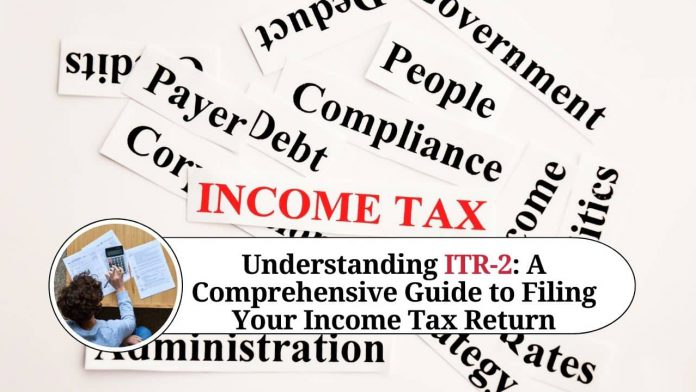Understanding ITR-2: Eligibility, Forms, and Filing Process
The Income Tax Return Form 2 (ITR-2) is a return form used by individual taxpayers who have income from multiple sources. It is a comprehensive form that helps you file your taxes and declare your income in a detailed manner. In this blog, we will cover everything you need to know about ITR-2, including eligibility criteria, form details, and the filing process.
Eligibility Criteria for ITR-2
ITR-2 is designed for individuals who have income from more than one source, such as salary, house property, capital gains, and income from other sources. If you have income from these sources and your income is above the basic exemption limit, you need to file ITR-2. Additionally, if you are a non-resident Indian (NRI) or a foreign national with Indian income, you need to file ITR-2.
Forms Required for Filing ITR-2
ITR-2 is a comprehensive form that requires you to provide detailed information about your income and deductions.
Here are some of the key forms you will need to file ITR-2:
Form 16: This is a form issued by your employer that contains details of your salary, taxes deducted, and other allowances.
Form 26AS: This form contains details of taxes paid by you and taxes deducted by your employer.
Form 15G/15H: If you are eligible for a tax exemption, you will need to submit Form 15G or 15H to your bank.
Bank Statements: You will need to provide bank statements for the financial year to show your income from interest and other sources.
Details of Investments: You will need to provide details of your investments such as mutual funds, stocks, and fixed deposits.
Filing Process for ITR-2
Filing ITR-2 is a simple process that can be done online. Here are the steps you need to follow to file your ITR-2:
Step 1: Log in to the e-filing website of the Income Tax Department.
Step 2: Download the ITR-2 form and fill in the required details.
Step 3: Upload the form and verify it using your Aadhaar card, net banking, or other options.
Step 4: Submit the form and wait for confirmation.
Note that you must file your ITR-2 before the due date to avoid penalties and interest charges. The due date for filing ITR-2 is typically July 31st of the relevant assessment year. However, for the FY 2021-22, the due date has been extended to December 31, 2022, due to the ongoing pandemic.
Additional Information About ITR-2
Here are some additional details you should know about ITR-2:
- Aadhaar Card: You need to provide your Aadhaar card number while filing ITR-2. It is mandatory for individuals to link their Aadhaar card with their PAN card to file their taxes. If you do not have an Aadhaar card, you can provide your Aadhaar enrolment number instead.
- Income Sources: ITR-2 is specifically designed for individuals who have income from multiple sources. The form allows you to declare your income from various sources, such as salary, house property, capital gains, and other sources.
- Capital Gains: If you have made any gains from the sale of assets such as stocks or property, you need to provide the details of the transaction, such as the date of purchase, sale price, and cost of acquisition. You will also need to declare the type of asset sold, such as equity shares or mutual funds.
- Tax Deductions: ITR-2 allows you to claim tax deductions for investments made during the financial year. You can claim deductions for investments made in instruments such as Public Provident Fund (PPF), Equity Linked Savings Scheme (ELSS), National Savings Certificate (NSC), and others. It is important to provide accurate details of all the deductions claimed.
- Verification Process: After filing your ITR-2, you need to verify it using one of the available options, such as Aadhaar OTP, Net banking, or Electronic Verification Code (EVC). The verification process is mandatory and failure to complete it can result in your ITR-2 being considered invalid.
Penalties for Late Filing of ITR-2
If you fail to file your ITR-2 by the due date, you may be liable to pay a penalty. The penalty for late filing of ITR-2 is as follows:
If you file your ITR-2 after the due date but before December 31 of the relevant assessment year, you may have to pay a penalty of Rs. 5,000.
If you file your ITR-2 after December 31 of the relevant assessment year but before March 31 of the next financial year, you may have to pay a penalty of Rs. 10,000.
If you file your ITR-2 after March 31 of the next financial year, you may have to pay a penalty of Rs. 10,000.
It is important to note that if your total income is less than Rs. 5 lakhs, the penalty for late filing is limited to Rs. 1,000.
Documents Required for Filing ITR-2
Here is a list of the documents that you will need to file your ITR-2:
- PAN card
- Aadhaar card
- Form 16 or salary certificate from your employer
- Bank statements for the financial year
- Details of all your investments, such as mutual funds, stocks, and fixed deposits
- Form 26AS
- Form 15G/15H (if applicable)
- Details of any capital gains made during the year
- Details of any other income, such as rental income or income from other sources
- Details of all tax deductions claimed during the year
Filing ITR-2 for NRI and Foreign Nationals
If you are an NRI or a foreign national with Indian income, you may be required to file ITR-2. However, the process for filing ITR-2 for NRIs and foreign nationals is slightly different from that for Indian residents. NRIs and foreign nationals may need to provide additional documents, such as a copy of their passport, visa, and other immigration documents.
Conclusion
ITR-2 is an important tax form that allows you to declare your income from multiple sources and claim deductions for tax purposes. By following the steps outlined in this blog, you can easily file your ITR-2 and ensure compliance with the Income Tax Act. Make sure to keep all your financial records and documents handy when filing your taxes to ensure accuracy and avoid any penalties or interest charges.
Read more useful content:
- How to Save Tax on Salary
- Guide to Understanding Direct Taxes in India
- Filing Income Tax Returns
- GST E-invoice
Frequently Asked Questions (FAQs)
Q1.) Who should file ITR-2?
ITR-2 should be filed by individuals and Hindu Undivided Families (HUFs) who have income from multiple sources, such as salary, house property, capital gains, and other sources.
Q2.) Can I file ITR-2 if I have income from business or profession?
No, if you have income from business or profession, you should file ITR-3 instead of ITR-2.
Q3.) Can I file ITR-2 if I have made capital gains from the sale of a property?
Yes, you can file ITR-2 if you have made capital gains from the sale of a property.
Q4.) Can I file ITR-2 if I have made capital gains from the sale of shares?
Yes, you can file ITR-2 if you have made capital gains from the sale of shares.
Q5.) Do I need to provide details of all my bank accounts in ITR-2?
No, you only need to provide details of the bank accounts in which you have received more than Rs. 10 lakhs in a year.
Q6.) Do I need to provide details of all my investments in ITR-2?
Yes, you need to provide details of all your investments in ITR-2, including mutual funds, stocks, and fixed deposits.
Q7.) Can I file ITR-2 without a digital signature?
Yes, you can file ITR-2 without a digital signature. In such a case, you will need to send a signed copy of the ITR-V to the Central Processing Centre (CPC) within 120 days of e-filing.
Q8.) Can I file ITR-2 after the due date?
Yes, you can file ITR-2 after the due date, but you may have to pay a penalty. The penalty for late filing of ITR-2 can be up to Rs. 10,000.
Q9.) Can I file ITR-2 for previous years?
Yes, you can file ITR-2 for previous years, but you may have to pay a penalty for late filing.
Q10.) What happens if I make a mistake while filing ITR-2?
If you make a mistake while filing ITR-2, you can file a revised return within the specified time limit. However, it is important to be accurate while filing ITR-2 to avoid any penalties or interest charges.




















